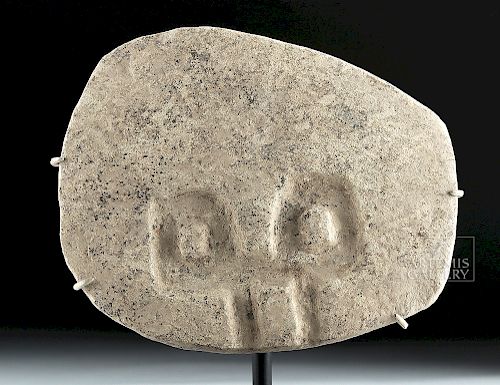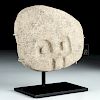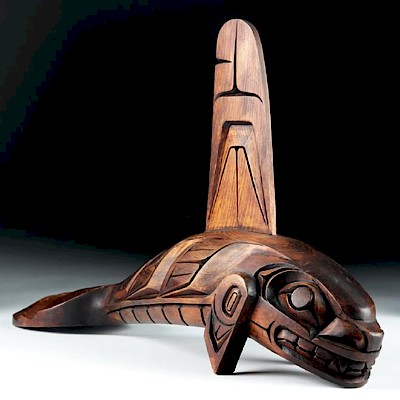Valdivian Limestone Plank Relief w/ Owl Eyes
Lot 68a
About Seller
Artemis Fine Arts
686 S Taylor Ave, Ste 106
Louisville, CO 80027
United States
Selling antiquities, ancient and ethnographic art online since 1993, Artemis Gallery specializes in Classical Antiquities (Egyptian, Greek, Roman, Near Eastern), Asian, Pre-Columbian, African / Tribal / Oceanographic art. Our extensive inventory includes pottery, stone, metal, wood, glass and textil...Read more
Estimate:
$2,500 - $3,500
Absentee vs Live bid
Two ways to bid:
- Leave a max absentee bid and the platform will bid on your behalf up to your maximum bid during the live auction.
- Bid live during the auction and your bids will be submitted real-time to the auctioneer.
Bid Increments
| Price | Bid Increment |
|---|---|
| $0 | $25 |
| $300 | $50 |
| $1,000 | $100 |
| $2,000 | $250 |
| $5,000 | $500 |
| $10,000 | $1,000 |
| $20,000 | $2,500 |
| $50,000 | $5,000 |
| $100,000 | $10,000 |
| $200,000 | $20,000 |
About Auction
By Artemis Fine Arts
May 24, 2018
Set Reminder
2018-05-24 10:00:00
2018-05-24 10:00:00
America/New_York
Bidsquare
Bidsquare : Northwest Coast, Tribal, & Pre-Columbian Art
https://www.bidsquare.com/auctions/artemis-gallery/northwest-coast-tribal-pre-columbian-art-3238
Featuring Pacific Northwest Coast Native American Art from respected collector / dealer, Joseph Alphabet. Artemis Fine Arts info@artemisfinearts.com
Featuring Pacific Northwest Coast Native American Art from respected collector / dealer, Joseph Alphabet. Artemis Fine Arts info@artemisfinearts.com
- Lot Description
Pre-Columbian, Ecuador, Earliest Horizon, Valdivian, ca. 2300 to 2000 BCE. A skillfully-executed limestone carving of a wide-eyed owl visage with streaming tear marks on a quasi-ovoid plank. The sculptor carved the bird of prey's visage with bold and deeply-carved straight lines on a rough grey limestone with nice mineral deposits. This aesthetic boasts attractive minimalism that appeals with our modern sensibilities and, yet, bespeaks of the ancient world. Custom museum-quality display stand included. Size: 6.25" W x 5" H (15.9 cm x 12.7 cm); 6.625" H (16.8 cm) on included custom stand.
Ancient stone steles from Ecuador like this example are among the oldest stone sculptures known to exist in the Americas, dating as far back as 3500 BCE. While each stele is unique, they do share a few common thematic characteristics. They are usually carved from a pearly-grey colored stone and are for the most part "blockish" in form, though this example shows rounded contours. The four most prominent themes include the owl, the serpent/arrow, the sun chart, and the star chart.
The owl was widely-symbolic in the Pre-Columbian world - revered as the creature who carried the sun during the night to ensure that it would always arise in the morning. Owls were considered of shamanic importance, guiding humans on their journeys to other worlds, the divine, and death. In some cultures, an anthropomorphic owl represented a warrior or war god. As a nocturnal bird of prey, the owl was also associated with night hunters, darkness, and the Underworld.
Provenance: private New York, New York, USA collection; ex-Patrick Hardy collection, Houston, Texas, USA
All items legal to buy/sell under U.S. Statute covering cultural patrimony Code 2600, CHAPTER 14, and are guaranteed to be as described or your money back.
A Certificate of Authenticity will accompany all winning bids.
We ship worldwide and handle all shipping in-house for your convenience.
#133919Surface wear and abrasions commensurate with age, small nicks and chips along peripheries, obverse, and reverse, with some light discoloration. Nice earthen and mineral deposits throughout.Condition
- Shipping Info
-
All shipping is handled in-house for your convenience. Your invoice from Artemis Gallery will include shipping calculation instructions. If in doubt, please inquire BEFORE bidding for estimated shipping costs for individual items.
-
- Buyer's Premium



 EUR
EUR CAD
CAD AUD
AUD GBP
GBP MXN
MXN HKD
HKD CNY
CNY MYR
MYR SEK
SEK SGD
SGD CHF
CHF THB
THB
















